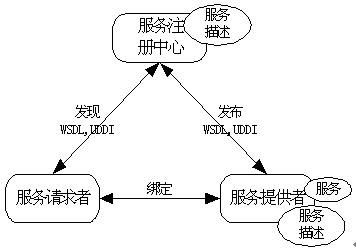Web Service进阶(一)运行原理
2015-04-07 09:09
288 查看
利用清明小假期,温习了一遍Web Service的相关内容,对其工作原理进行了简要总结。以供有需求的朋友和自己日后参考。文章若有不当之处,敬请朋友们提出宝贵建议,以求共勉。
Web服务中,我们应该首先了解相关的术语含义:WSDL、UDDI....相关术语方面的介绍在此不再赘述,重点放在原理上。
在Web服务中,存在三个角色:服务提供者、服务请求者和服务中介,三者之间的关系如图1-1所示:(摘录自:http://www.cnblogs.com/Jessy/p/3528341.html)。
实现一个完整的Web服务包括以下步骤:
◆ Web服务提供者设计实现Web服务,并将调试正确后的Web服务通过Web服务中介者发布,并在UDDI注册中心注册; (发布)
◆ Web服务请求者向Web服务中介者请求特定的服务,中介者根据请求查询UDDI注册中心,为请求者寻找满足请求的服务; (发现)
◆ Web服务中介者向Web服务请求者返回满足条件的Web服务描述信息,该描述信息用WSDL写成,各种支持Web服务的机器都能阅读;(发现)
◆ 利用从Web服务中介者返回的描述信息(WSDL)生成相应的SOAP消息,发送给Web服务提供者,以实现Web服务的调用;(绑定)
◆ Web服务提供者按SOAP消息执行相应的Web服务,并将服务结果返回给Web服务请求者。(绑定)

图1-1 Web
service的体系结构
注:WSDL的作用就是一个Web服务说明书。服务请求者根据此WSDL生成相应的SOAP消息,服务提供者在收到SOAP请求消息后,进行服务的绑定。
以下代码是在web.xml中的servlet配置
<!-- 在向servlet或JSP页面制定初始化参数或定制URL时,必须首先命名servlet或JSP页面。Servlet元素就是用来完成此项任务的。 -->
<servlet>
<servlet-name>UserService</servlet-name>
<servlet-class>com.sun.xml.ws.transport.http.servlet.WSServlet</servlet-class>
<!-- 标记容器是否在启动的时候就加载这个servlet(实例化并调用其init()方法;正数的值越小,该servlet的优先级越高,应用启动时就越先加载 -->
<load-on-startup>1</load-on-startup>
</servlet>
<!-- 服务器一般为servlet提供一个缺省的URL:http://host/webAppPrefix/servlet/ServletName。但是,常常会更改这个URL,
以便servlet可以访问初始化参数或更容易地处理相对URL。在更改缺省URL时,使用servlet-mapping元素。 -->
<servlet-mapping>
<servlet-name>UserService</servlet-name>
<!-- 描述了相对于Web应用的根目录的URL。url-pattern元素的值必须以斜杠(/)起始。 -->
<url-pattern>/user</url-pattern>
</servlet-mapping>
红色代码部分很重要,会在Web容器启动的时候加载相应的servlet。绿色部分为该服务的外部接口。以此找到相应的jax-ws.xml文件(如下所示)
<endpoint name="UserPort" implementation="cn.ujn.service.UserService"
url-pattern="/user">
</endpoint>
进而绑定到相关的相应的实现类cn.ujn.service.UserService中。客户端发送的SOAP请求消息消息体body中包含有客户端所请求的方法名和参数信息。
以下为客户端封装的soap消息体(以Json方式与服务端进行数据传输)(SOAP Rerquest Envelope):
<soapenv:Envelope
xmlns:soapenv="http://schemas.xmlsoap.org/soap/envelope/"
xmlns:q0="http://ujn.cn/" xmlns:xsd="http://www.w3.org/2001/XMLSchema"
xmlns:xsi="http://www.w3.org/2001/XMLSchema-instance">
-<soapenv:Body>
-<q0:login>
<arg0>{"username":"shq","password":"shq"}</arg0>
</q0:login>
</soapenv:Body>
</soapenv:Envelope>
以下为SOAP1.1协议调用Web服务
/**
* 通过SOAP1.1协议调用Web服务
*
* text/xml 这是基于soap1.1协议
*
* @param wsdl
WSDL路径
* @param method方法名
* @param namespace命名空间
* @param headerParameters 头参数
* @param bodyParameters 体参数
* @param isBodyParametersNS 体参数是否有命名空间
* @return
String
* @throws Exception
*/
public static String invokeBySoap11(String wsdl, String method,
String namespace, Map<String, String> headerParameters,
Map<String, String> bodyParameters, boolean isBodyParametersNS)
throws Exception {
StringBuffer soapOfResult = null;
// 去除 ?wsdl,获取方法列表
int length = wsdl.length();
wsdl = wsdl.substring(0, length - 5);
//以字符串为参数创建URL实例
URL url = new URL(wsdl);
//创建连接
HttpURLConnection conn = (HttpURLConnection) url.openConnection();
//设置请求方式
conn.setRequestMethod("POST");
//如果打算使用 URL连接进行输入,则将 DoInput 标志设置为 true
conn.setDoInput(true);
//如果打算使用 URL连接进行输出,则将 DoInput 标志设置为 true
conn.setDoOutput(true);
//主要是设置HttpURLConnection请求头里面的属性(K-V)
conn.setRequestProperty("Content-Type", "text/xml;charset=utf-8");
//获取输入流(相对于客户端来说,使用的是OutputStream)
OutputStream out = conn.getOutputStream();
// 获取soap1.1版本消息
StringBuilder sb = new StringBuilder();
sb.append("<soap:Envelope xmlns:xsi=\"http://www.w3.org/2001/XMLSchema-instance\"
xmlns:xsd=\"http://www.w3.org/2001/XMLSchema\" xmlns:soap=\"http://schemas.xmlsoap.org/soap/envelope/\"
");
sb.append("xmlns:ns0=\"" + namespace + "\"");
sb.append(">");
//拼装消息头
if (headerParameters != null) {
sb.append("<soap:Header>");
for (Entry<String, String> headerParameter : headerParameters
.entrySet()) {
sb.append("<ns0:");
sb.append(headerParameter.getKey());
sb.append(">");
sb.append(headerParameter.getValue());
sb.append("</ns0:");
sb.append(headerParameter.getKey());
sb.append(">");
}
sb.append("</soap:Header>");
}
//拼装消息体
sb.append("<soap:Body><ns0:");
sb.append(method);
sb.append(">");
// 输入参数
if (bodyParameters != null) {
for (Entry<String, String> inputParameter : bodyParameters
.entrySet()) {
if (isBodyParametersNS) {
sb.append("<ns0:");
sb.append(inputParameter.getKey());
sb.append(">");
sb.append(inputParameter.getValue());
sb.append("</ns0:");
sb.append(inputParameter.getKey());
sb.append(">");
} else {
sb.append("<");
sb.append(inputParameter.getKey());
sb.append(">");
sb.append(inputParameter.getValue());
sb.append("</");
sb.append(inputParameter.getKey());
sb.append(">");
}
}
}
sb.append("</ns0:");
sb.append(method);
sb.append("></soap:Body></soap:Envelope>");
//测试用
System.out.println(sb.toString());
//写入SOAP消息(相对于客户端来说,使用的是out.write())
out.write(sb.toString().getBytes());
//获取服务器端的相应
int code = conn.getResponseCode();
if (code == 200) {
InputStream is = conn.getInputStream();
byte[] b = new byte[1024];
int len = 0;
soapOfResult = new StringBuffer();
//从输入流中读取一定数量的字节,并将其存储在缓冲区数组 b 中。以整数形式返回实际读取的字节数
//如果因为流位于文件末尾而没有可用的字节,则返回值 -1;
while ((len = is.read(b)) != -1) {
//Converts the byte array to a string using the named charset.
String s = new String(b, 0, len, "UTF-8");
soapOfResult.append(s);
}
}
conn.disconnect();
return soapOfResult == null ? null : soapOfResult.toString();
}
注:在客户端发送SOAP请求消息后便处于阻塞状态。直至服务端返回状态码。
以下为服务端进行响应(SOAP Response Envelope):
<S:Envelope xmlns:S="http://schemas.xmlsoap.org/soap/envelope/">
-<S:Body>
-<ns2:loginResponse
xmlns:ns2="http://ujn.cn/">
<return>1</return>
</ns2:loginResponse>
</S:Body>
</S:Envelope>
客户端接收到服务端发来的Json数据后会进行相应的解析操作。如下:
// 将Soap协议进行解析(DOM解析只能用于解析XML文档类型,而SOAP消息就是采用XML数据格式)
Document doc = XmlUtil.string2Doc(result);
Element ele = (Element) doc.getElementsByTagName("return").item(0);
方法中使用到的string2Doc()方法体如下:
public static Document string2Doc(String str) {
//将XML文档解析成DOM树
DocumentBuilderFactory factory = DocumentBuilderFactory.newInstance();
Document document = null;
DocumentBuilder build;
if (str == null || str.equals("")) {
return null;
}
try {
InputStream bais = new ByteArrayInputStream(str.getBytes("UTF-8"));
build = factory.newDocumentBuilder();
//Parse the content of the given InputStream as an XML document and return a new DOM Document object.
document = build.parse(bais);
} catch (Exception e) {
e.printStackTrace();
}
return document;
}
根据返回结果,客户端再进行相应的处理。
以上是web服务的基本工作原理。在此感谢实验室徐师兄的技术支持。
Web服务中,我们应该首先了解相关的术语含义:WSDL、UDDI....相关术语方面的介绍在此不再赘述,重点放在原理上。
在Web服务中,存在三个角色:服务提供者、服务请求者和服务中介,三者之间的关系如图1-1所示:(摘录自:http://www.cnblogs.com/Jessy/p/3528341.html)。
实现一个完整的Web服务包括以下步骤:
◆ Web服务提供者设计实现Web服务,并将调试正确后的Web服务通过Web服务中介者发布,并在UDDI注册中心注册; (发布)
◆ Web服务请求者向Web服务中介者请求特定的服务,中介者根据请求查询UDDI注册中心,为请求者寻找满足请求的服务; (发现)
◆ Web服务中介者向Web服务请求者返回满足条件的Web服务描述信息,该描述信息用WSDL写成,各种支持Web服务的机器都能阅读;(发现)
◆ 利用从Web服务中介者返回的描述信息(WSDL)生成相应的SOAP消息,发送给Web服务提供者,以实现Web服务的调用;(绑定)
◆ Web服务提供者按SOAP消息执行相应的Web服务,并将服务结果返回给Web服务请求者。(绑定)

图1-1 Web
service的体系结构
注:WSDL的作用就是一个Web服务说明书。服务请求者根据此WSDL生成相应的SOAP消息,服务提供者在收到SOAP请求消息后,进行服务的绑定。
以下代码是在web.xml中的servlet配置
<!-- 在向servlet或JSP页面制定初始化参数或定制URL时,必须首先命名servlet或JSP页面。Servlet元素就是用来完成此项任务的。 -->
<servlet>
<servlet-name>UserService</servlet-name>
<servlet-class>com.sun.xml.ws.transport.http.servlet.WSServlet</servlet-class>
<!-- 标记容器是否在启动的时候就加载这个servlet(实例化并调用其init()方法;正数的值越小,该servlet的优先级越高,应用启动时就越先加载 -->
<load-on-startup>1</load-on-startup>
</servlet>
<!-- 服务器一般为servlet提供一个缺省的URL:http://host/webAppPrefix/servlet/ServletName。但是,常常会更改这个URL,
以便servlet可以访问初始化参数或更容易地处理相对URL。在更改缺省URL时,使用servlet-mapping元素。 -->
<servlet-mapping>
<servlet-name>UserService</servlet-name>
<!-- 描述了相对于Web应用的根目录的URL。url-pattern元素的值必须以斜杠(/)起始。 -->
<url-pattern>/user</url-pattern>
</servlet-mapping>
红色代码部分很重要,会在Web容器启动的时候加载相应的servlet。绿色部分为该服务的外部接口。以此找到相应的jax-ws.xml文件(如下所示)
<endpoint name="UserPort" implementation="cn.ujn.service.UserService"
url-pattern="/user">
</endpoint>
进而绑定到相关的相应的实现类cn.ujn.service.UserService中。客户端发送的SOAP请求消息消息体body中包含有客户端所请求的方法名和参数信息。
以下为客户端封装的soap消息体(以Json方式与服务端进行数据传输)(SOAP Rerquest Envelope):
<soapenv:Envelope
xmlns:soapenv="http://schemas.xmlsoap.org/soap/envelope/"
xmlns:q0="http://ujn.cn/" xmlns:xsd="http://www.w3.org/2001/XMLSchema"
xmlns:xsi="http://www.w3.org/2001/XMLSchema-instance">
-<soapenv:Body>
-<q0:login>
<arg0>{"username":"shq","password":"shq"}</arg0>
</q0:login>
</soapenv:Body>
</soapenv:Envelope>
以下为SOAP1.1协议调用Web服务
/**
* 通过SOAP1.1协议调用Web服务
*
* text/xml 这是基于soap1.1协议
*
* @param wsdl
WSDL路径
* @param method方法名
* @param namespace命名空间
* @param headerParameters 头参数
* @param bodyParameters 体参数
* @param isBodyParametersNS 体参数是否有命名空间
* @return
String
* @throws Exception
*/
public static String invokeBySoap11(String wsdl, String method,
String namespace, Map<String, String> headerParameters,
Map<String, String> bodyParameters, boolean isBodyParametersNS)
throws Exception {
StringBuffer soapOfResult = null;
// 去除 ?wsdl,获取方法列表
int length = wsdl.length();
wsdl = wsdl.substring(0, length - 5);
//以字符串为参数创建URL实例
URL url = new URL(wsdl);
//创建连接
HttpURLConnection conn = (HttpURLConnection) url.openConnection();
//设置请求方式
conn.setRequestMethod("POST");
//如果打算使用 URL连接进行输入,则将 DoInput 标志设置为 true
conn.setDoInput(true);
//如果打算使用 URL连接进行输出,则将 DoInput 标志设置为 true
conn.setDoOutput(true);
//主要是设置HttpURLConnection请求头里面的属性(K-V)
conn.setRequestProperty("Content-Type", "text/xml;charset=utf-8");
//获取输入流(相对于客户端来说,使用的是OutputStream)
OutputStream out = conn.getOutputStream();
// 获取soap1.1版本消息
StringBuilder sb = new StringBuilder();
sb.append("<soap:Envelope xmlns:xsi=\"http://www.w3.org/2001/XMLSchema-instance\"
xmlns:xsd=\"http://www.w3.org/2001/XMLSchema\" xmlns:soap=\"http://schemas.xmlsoap.org/soap/envelope/\"
");
sb.append("xmlns:ns0=\"" + namespace + "\"");
sb.append(">");
//拼装消息头
if (headerParameters != null) {
sb.append("<soap:Header>");
for (Entry<String, String> headerParameter : headerParameters
.entrySet()) {
sb.append("<ns0:");
sb.append(headerParameter.getKey());
sb.append(">");
sb.append(headerParameter.getValue());
sb.append("</ns0:");
sb.append(headerParameter.getKey());
sb.append(">");
}
sb.append("</soap:Header>");
}
//拼装消息体
sb.append("<soap:Body><ns0:");
sb.append(method);
sb.append(">");
// 输入参数
if (bodyParameters != null) {
for (Entry<String, String> inputParameter : bodyParameters
.entrySet()) {
if (isBodyParametersNS) {
sb.append("<ns0:");
sb.append(inputParameter.getKey());
sb.append(">");
sb.append(inputParameter.getValue());
sb.append("</ns0:");
sb.append(inputParameter.getKey());
sb.append(">");
} else {
sb.append("<");
sb.append(inputParameter.getKey());
sb.append(">");
sb.append(inputParameter.getValue());
sb.append("</");
sb.append(inputParameter.getKey());
sb.append(">");
}
}
}
sb.append("</ns0:");
sb.append(method);
sb.append("></soap:Body></soap:Envelope>");
//测试用
System.out.println(sb.toString());
//写入SOAP消息(相对于客户端来说,使用的是out.write())
out.write(sb.toString().getBytes());
//获取服务器端的相应
int code = conn.getResponseCode();
if (code == 200) {
InputStream is = conn.getInputStream();
byte[] b = new byte[1024];
int len = 0;
soapOfResult = new StringBuffer();
//从输入流中读取一定数量的字节,并将其存储在缓冲区数组 b 中。以整数形式返回实际读取的字节数
//如果因为流位于文件末尾而没有可用的字节,则返回值 -1;
while ((len = is.read(b)) != -1) {
//Converts the byte array to a string using the named charset.
String s = new String(b, 0, len, "UTF-8");
soapOfResult.append(s);
}
}
conn.disconnect();
return soapOfResult == null ? null : soapOfResult.toString();
}
注:在客户端发送SOAP请求消息后便处于阻塞状态。直至服务端返回状态码。
以下为服务端进行响应(SOAP Response Envelope):
<S:Envelope xmlns:S="http://schemas.xmlsoap.org/soap/envelope/">
-<S:Body>
-<ns2:loginResponse
xmlns:ns2="http://ujn.cn/">
<return>1</return>
</ns2:loginResponse>
</S:Body>
</S:Envelope>
客户端接收到服务端发来的Json数据后会进行相应的解析操作。如下:
// 将Soap协议进行解析(DOM解析只能用于解析XML文档类型,而SOAP消息就是采用XML数据格式)
Document doc = XmlUtil.string2Doc(result);
Element ele = (Element) doc.getElementsByTagName("return").item(0);
方法中使用到的string2Doc()方法体如下:
public static Document string2Doc(String str) {
//将XML文档解析成DOM树
DocumentBuilderFactory factory = DocumentBuilderFactory.newInstance();
Document document = null;
DocumentBuilder build;
if (str == null || str.equals("")) {
return null;
}
try {
InputStream bais = new ByteArrayInputStream(str.getBytes("UTF-8"));
build = factory.newDocumentBuilder();
//Parse the content of the given InputStream as an XML document and return a new DOM Document object.
document = build.parse(bais);
} catch (Exception e) {
e.printStackTrace();
}
return document;
}
根据返回结果,客户端再进行相应的处理。
以上是web服务的基本工作原理。在此感谢实验室徐师兄的技术支持。
相关文章推荐
- Web Service进阶(一)运行原理
- MyBatis进阶(一)运行原理
- Struts2进阶(一)运行原理及搭建步骤
- Web Service 运行原理详细介绍
- Struts2进阶(一)运行原理
- 【Java进阶-Java动态代理与AOP】05 分析InvocationHandler对象的运行原理
- MyBatis进阶(一)运行原理
- Python进阶(五十)-解析Flask运行原理
- Lesson1 Windows程序内部运行原理 ---孙鑫VC++教程
- CLR 中类型字段的运行时内存布局 (Layout) 原理浅析 [2]
- 绿色SQL Server原理(1)Sqlservr.exe 运行参数
- Lesson1 Windows程序内部运行原理 ---孙鑫VC++教程
- JSP培训(2)——运行原理、文档结构、简单输入输出
- 学习笔记——windows程序运行原理
- VC++深入详解学习笔记-windows程序运行原理
- VC++学习笔记——Windows程序内部运行原理
- (转载)通过MSIL了解CLR的运行原理
- ajax的原理和运行机制
- Java的安装、配置和运行的基本过程及其原理!
- 第二章 Win32程序运行原理
